We publish the video where the strong Spanish triathlete JAVIER GOMEZ NOYA engaged in a training session in which performs some valuable travel technique exercises. To see!
 The discipline of Triathlon is developing exponentially more and more among the amateur world; more and more amateur athletes pass from a single activity, such as podium, cycling, swimming, to multidisciplinary, or in any case complement their collateral workouts with respect to Their main discipline. We have seen in several articles the reasons why many amateurs choose the Triathlon:
The discipline of Triathlon is developing exponentially more and more among the amateur world; more and more amateur athletes pass from a single activity, such as podium, cycling, swimming, to multidisciplinary, or in any case complement their collateral workouts with respect to Their main discipline. We have seen in several articles the reasons why many amateurs choose the Triathlon:
· Minor injuries and therefore more frequent workouts
· Greater sports life (longevity)
· Better results even in single discipline
· Better maintenance of body weight
· Best body balance between the different segments
· Greater self-esteem and greater awareness of their potential
· May Motivation in Practicing Physical Activity
In the same way and simplicity that many athletes from the single discipline to Triathlon practice, it is not possible to consider the organizational aspects of training, nutrition and eventual integration as simplistic. In fact, an aspect that characterizes and differentiates Triathlon with respect to the single discipline (Race, Cycling or Swimming) is precisely the organizational and complexity of combining workouts, double daily sessions, nutrition and integration to be programmed, and in sessions Training and both in the race. This does not mean that it is impossible, but only that you need to leave nothing to chance to avoid management training issues and racing and to continue practicing this wonderful discipline to everyone's reach. So let's look at how best to be able to get organized during workouts and sports integration. Bearing in mind that, especially for those who come from racing and swimming, the triathlon is best able to feed and integrate even during workout due to the use of the bike in the combined sessions or because of the availability of the bath edge For Swimming.
Triathlon feeding
As for the triathlon feeding, it is assumed that you definitely need more caloric gain during the day and the whole week available for workouts than in the single discipline. We do not hypothesize training sessions like IronMan, but already for an Olympic and Ironman 70.3 race preparation, you need to pay close attention to what you are eating, both in quantity and as food quality, and how to Hiring during the training day. We refer to several examples of training during the day!
1. Morning training Swimming 1Hora + Bike 2h00
In this case, we assume that workout starts at 7.00 in the morning with an hour of Swimming and continue with the Cycle for about 2 hours. Surely we will not have the chance to have breakfast, but we could handle the nutrition and integration as follows.
· 6.00 o'clock Light breakfast (Slices 2 + jam + juice or juice)
· 7.00 pm Swimming Training (during Mineral Saline Training)
· 8.00 am Cycle Start Training (during Training Integration with an Energizing Barrette with Mineral Salt, Carbohydrate, and Branched Amino Acids in a Single Solution)
· Hours 10.00 Immediately after training Integration with product for energy and muscle recovery (Carbohydrates, Mineral salts, Amino Acids, Glutamine) to follow Breakfast (Sliced jam and honey snacks + cereal and milk or soy drink, or rice, fresh fruit, fruit Dried nuts or almonds, fruit juice).
2. Lunch break training Lunch 1Hora + 1h30
In this case, we assume that the workout begins at 13.00 with an hour of Swimming and continue with the Race for about 1h30 'assuming a basic aerobic workout. Surely we will have a good breakfast and a snack in the middle of the morning if the work permits.
· 7.00 o'clock Breakfast with roasted slices (or Rice / Butter / Cereal Gallettes) jam and honey, cereals and milk or derivatives, fresh fruit, juice or juice, dried fruit (nuts or almonds). Omega3 Integration!
· 11.30 am Sandwich with Bresaola or Turkey or Salmon or Fresh Fruit Yogurt
· 12.30 pm Idrosaline Solution Pre Race Endurance
· 13.00 Swimming Training (Drinking Water with Addition of Salt and Maltodextrine)
· 14.00 Training Course
· 15.30 pm Muscle and Energy Recovery Integration
· Follow Lunch with Rice or Pasta with Tomato or with Oil + Chicken Chicken + Fruit; If you do not have the opportunity to eat it is good rice salad with tuna!
3. Afternoon / Evening Training Swimming 1 hour or 1h00 or Cycling 2h00
As above in this case, we will have to eat breakfast, snack mid-morning, lunch and snack mid-afternoon. In this way, when we do the training we will not need much, possibly only a mineral solution, carbohydrate with different assimilation, branched amino acids and glutamine to prevent muscle fatigue.
Regardless of what you prefer to eat and integrate before, during and after workout, it is essential to keep in mind some general rules and tips that can make you live a good workout (or race) without having any energy drops making the most of your potential. These rules are valid whether you train early in the morning, at lunch breaks, or in the afternoon / afternoon work.
GENERAL ADVICE AND INDICATIONS POWER MANAGEMENT
· If you do not have the opportunity to have breakfast in the morning before training, it should be integrated during training with mineral salts, carbohydrates and amino acids. Between a session and the other may eat a small energy bar.
· How Much is Combined Workout Swimming and Cycling is preferable to integrate during cycling sessions even with something solid (energy bars) or liquid solution containing mineral salts, carbohydrates and amino acids.
· When combining Swimming and Running Combined Workouts, it is preferable to get full of energy before starting swimming session and between a discipline and the other drinking solution for energy and muscle recovery or an easy-digesting energy bar to prepare for Better at the second session (race).
· After combined training it is always better in the 20'00-30'00 post workout to integrate with a recovery solution containing both mineral salts, carbodrates, branched amino acids and glutamine. After this time it becomes harder to recover, especially if we then have a double training session, which often happens for those who do Triathlon.
· It is preferable not to skip meals during training days and especially after training, as muscle and energy recovery would be really compromised, even in the days to come, feeling more tired. So always get organized with the chance to leave me a 30'00 to have lunch or have breakfast right after the workout.
These are the main indications that you should adapt to your needs but that, however, are good for everyone if you are able to apply it best, bearing in mind that recovery post training and then the success of the next training depends on how your body has Recovered and eliminated the previous workout toxins. This means giving a lot of importance to both pre-workout feeding and training integration, and to post-workout (or race) nutrition and integration.
As I always conclude, remembering that these are not empirical indications, but they have to be put into practice every day in each workout to figure out what the solution is to improve for your own needs and technical / physical features! Try to improve your workout and better deal with Triple Discipline.
Good Triathlon and Fun!
By Prof. Ignazio Antonacci
Arena debuts in the world of triathlon triathlon clothing and body offering made with the same CARBON fiber POWERSKIN PRO that has collected many successes in the world of competitive swimming. It's the same fabric used for the costumes of swimmers race world champions and Olympic medalists. Here is a short video that explains the technical features of this amazing fabric. Available from MOTUS.
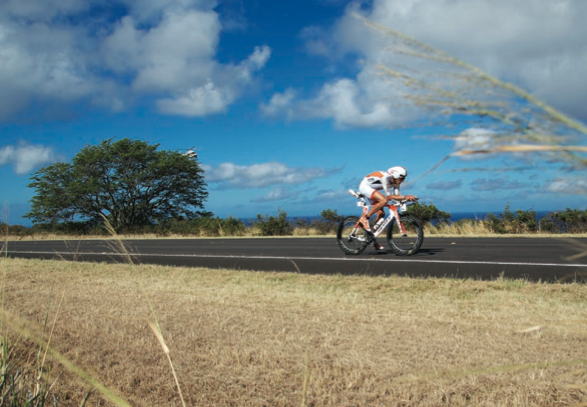 Professional triathletes may have more time to workout, but that does not mean that we can not take their best ideas and do ours. You can copy pros on how to structure your training intelligently and with clear goals for your upcoming Ironman
Professional triathletes may have more time to workout, but that does not mean that we can not take their best ideas and do ours. You can copy pros on how to structure your training intelligently and with clear goals for your upcoming Ironman
The Ironman sample training is structured in blocks of three weeks, or training mesocycles, each with a particular objective. Age class athletes can benefit from taking such a general approach to training, starting with a basic structure that also includes some specific goals within each batch. When an Age Group athlete joins an Ironman, this contest often tends to be their annual annual event in the sense that it is the focal point of their season. By working backwards from Ironman's date, here's an example of mesocycle creation. Note that you can formulate a similar plan for all distances by adjusting volume and intensity.
Key Sessions for 10 Weeks Before an Ironman:
Having a well-liked plan and setting the timeline goals with particular attention to different energy systems greatly increases your chances of success. Structure the plan in blocks of three weeks: two weeks of construction followed by a week of recovery. One week of recovery should include two full days without training, and be about 50 to 65 percent of the previous week's workout volume.
1-3 weeks
(8-10 weeks before Ironman) Emphasis: aerobic ability
The athlete must be fit before commencing this midwifery, and the goal is to build strength through the specific movements of sports (swimming, biking and running) and resistance. Limit the intensity of the sessions so you can run multiple days of high volume training.
Training objective :
Two weeks of resistance in swimming, bike and run, focused on building aerobic strength and strength, followed by a week of recovery.
Key Sessions to Build Resistance and Strength:
• aerobic resistance pedals of 4.5 to 6.5 hours. Include long climbs, if possible.
• aerobic resistance stroke of 1.5 to 2.5 hours. Run on a hilly terrain.
• Low pedaling rate, more effort of 10-30 minutes at 55-65 rpm to build strength.
• Swimming with force pallets.
Weeks 4-7
(5-7 weeks before Ironman) Emphasis: aerobic capacity and stimulation
Physical resistance continues, but you begin to get in touch with the target gait, training on a ground that simulates your Ironman. After adjusting to the longer sessions of the previous training block, your goal is now to swim, ride and run a little faster on long distances. The emphasis is on building an efficiency target for the Ironman.
Training objective:
Two weeks of bike and race resistance with focus on the pace and race pace, followed by a week of recovery. Main Sessions:
• 4.5-6 hours aerobic pedaling, including 3-4 20 to 45 minute intervals at Ironman racing pace on your aerodynamic appendages. Driving on land similar to the target race.
• Get out of the bike, run at a racing pace for 15-60 minutes, on a plot similar to your Ironman goal.
• 1.5 to 2.5 hours of aerobic strength run, hardening to maintain strength
• Pedal in low cadence, more 10-30 minutes effort at 55-65 laps to support the force.
• Aerobic power swimming: long series like 3 × 1000 meters or a continuous 3000, inspired by the rhythm of the race, Possibly also swimming in the open sea
Weeks 7-8
(3-4 weeks before Ironman) Emphasis: aerobic power
Now you set up for your race. The goal of this training block is to reach the peak shape for your event. Reduce overall training volume by about 20 percent. The goal is not to go on long distances, but rather to challenge the aerobic system and optimize your body for the day of the race.
Training Objective:
Two weeks of aerobic power building with the aim of pedaling and running faster than the Ironman race pitch.
Main Sessions:
• An aerobic bicycle output per week of 4-5 hours, including 3-4 terrain-like terrain ranges, which is 1.5-3km / h faster than the Ironman race rhythm (or 5-10 beats of frequency Cardiac over the Ironman target ) on the aerodynamic appendices.
• Get out of the bike, run at a racing pace for 15-60 minutes, on a plot similar to your Ironman goal.
• Aerobic power travel for each week of 1.5-2 hours in a field similar to that of the race; Run for two-thirds at Ironman racing rhythm and finish the last third of the race at the rhythm of a Half Ironman
• swimming set at the lattice threshold, such as 20 × 100 meters with 30 seconds of rest, trying to turn the 100mt 3-5 seconds faster than Ironman's rhythm.
Weeks 9-10
(1-2 weeks before Ironman) Emphasis: Recovery and RACE!
The job is done, and the last two weeks are to absorb your workout and sharpen everything for the day of the race. It's important to stay mentally engaged and focus on sessions.
Training Objective :
• Assign the last two weeks before the race tapering. Start with 3-5 days of rest and light activity.
• The next 4-6 days are for "activation" (shorter training sessions at race speed).
• The last 3-5 days are for more rest and preparation of the race day
From the blog of Stephen Dear, here is a training program for the fraction of a swimming Olympic Triathlon. It is a program designed by Akeem adekunle Giagu divided into 14 weeks of training. We think may be of help to many: simple and effective.
14 weeks swimming program
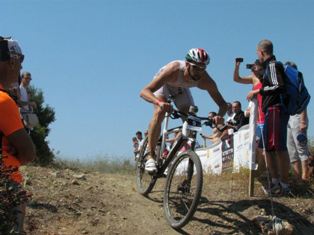 I thought to do some performance testing before the new season.As evidence it makes more sense for triathletes?
I thought to do some performance testing before the new season.As evidence it makes more sense for triathletes?
Before you spend your hard-earned cash on a test, you should know what you hope to get from the test, how do you use the information and what are the limitations of the test.When the test is done periodically throughout the season, each test can be compared with the previous one to help you and your coach to determine whether the approach to training is improving your fitness.
In an ideal world, every athlete can obtain test results VO2max, lactate and field tests three or four times during the year, but they are just too expensive.So which test is right for you?
Lactate testing
The aim is to assess your lactate threshold to help create training areas and to measure the response to training, if carried out throughout the year.Athletes must hop on a treadmill or on a stationary bike, the intensity increases every few minutes, and a small bite of blood is taken for each incremental step.
VO2max
Since VO2max is not a predictor of performance, is less functional than a lactate test.However, many people are simply curious to learn their VO2max.Additional data, such as any patient and anaerobic thresholds can be computed in such a way as to set training zones.The test protocol is the same as that of lactate test, except that instead of taking a drop of blood, the athletes must wear a mask to measure the gases exhaled from the lungs.This test is more beneficial if done in conjunction with a lactate test.
DIY test
Main disadvantages of lab tests are the cost (usually $ 100 each) and the inconvenience involved.Alternatively, home field trials are free and sometimes equally benefits.Time 20.30 efforts or 60 minutes or a 5 k or 10 k race pace can be done frequently and can serve as a functional assessment of your current fitness level.
Choose a test method that is within your budget, bearing in mind that repeat tests during training cycles is more useful than doing a single test in low season.If VO2max or lactate test you intrigued, you can find a local lab or a coach who can run and collect as much data as possible from it.If you only want to track the progress, field trials will give you practical information and free.
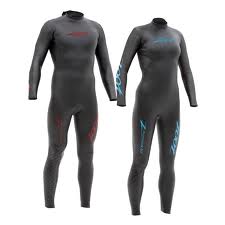 What factors to consider when choosing a mute?
What factors to consider when choosing a mute? The purposes and effects of ice, application practiced by many professional coaches
For some time the ice was used
as relief from fatigue and to decrease
inflammations. Especially since the
RICE method became common, many
athletes and coaches have praised the ice
as a tool for first responders.
The purpose of the application of ice
Pain relief
The numbness of the region from pain relief.
Reduction of swelling
The blood vessels contract to reduce the payment
of blood inside.
Decrease in inflammation
Restricts the activity of surrounding tissue injury in order to
avoid the aggravation.
Recovery from fatigue
The blood vessels contract temporarily. You
accelerates the dissolution/absorption of lactic acid.
Return to immediate field
Temporary desensitization of the affected region.
It facilitates rehabilitation exercises.
The initial approach of treating RICE is
effective in the acute phase of injury.
The RICE treatment consists of rest/ice/compression/
elevation.
1-free: If you have suffered an injury, rest
sitting on the floor or on a Chair for
prevent deterioration.
2-ICING (ice application): relieve swelling,
muscle cramps and pain by applying an ice
on the affected area.
3-compression: Prevent localized swelling and
reduce pain by compressing the area properly.
Ask the injured if it considers that the compression
applied is correct.
4-elevation: bring the affected region above the
heart level in order to avoid additional payment
of blood inside.
The application of ice is a phase
important in treating RICE.
After the accident they feel symptoms of inflammation
such as pain and swelling.
Without treatment, the damage gets worse and recovery
will be slower. Reduces ice damage by limiting pain and
swelling, also favours a rapid recovery.
Application of cold therapy
using the RICE method.
Apply ice on the affected region for
between 20 and 30 minutes.
The sensations in the affected area
follow four distinct phases:
1. you feel pins and needles.
2. cutaneous pain and feeling
burning.
3. There is a pulsing sensation/hammering.
4. numbness of the skin.
Suspend the application of ice and compress
compression for 30 minutes.
Repeat the sequence several times, depending on the severity
the lesion.
ICE THERAPY
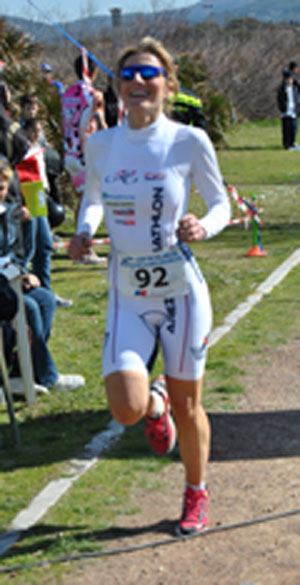 What does speed training mean?
What does speed training mean?
Achilles tendon and related trauma
The Achilles tendon is thicker curtains around the body.Is protected by serum and bags by a fibrous sheath which guarantees scrolling. Connects the calf muscles to the heel bone (1). Therefore is essential during propulsion.
The Achilles Tendonitis
The causes of this disease are manifold: repeated friction and impacts; excessive load, a wrong movement or inadequate hydration; unsuitable shoes or postural disorders of the foot (flat feet or cables); insufficient heating or stretching; change in the area of training, etc.
This involves tendinopathy acute pain, which may not be alerted to hot tendon. However, neglecting the problem the athlete won't be able to compete or train. Sport suspension, ice application, physiotherapy and chiropody treatments become a priority when a tendinopathy.
Shoulder shape
The shoulder consists of bones, muscles, superficial and deep. If you have a muscle imbalance and superficial muscles are stronger than the deep muscles, the shoulder is exposed to the risk of injury.
Serious injury of the shoulder
Rotator cuff injury
The rotator cuff is subject to considerable stresses and suffers injuries caused by sudden rotation of the shoulder joint. The most common cause of this injury are launching repeated movements such as those of sports like baseball. Symptoms are pain and fatigue in the lift arm.
Erosion syndrome
The main cause is the pressure applied to the tendon of the supraspinatus muscle, located between the humerus and the acromion. Pain is felt in the region between the shoulder and upper arm, the pain intensifies raised arm and is warned to infraspinato muscle tendon. If the injury is caused by abnormal movements due to unequal strength of the muscles that surround the shoulder.
Luxation (dislocation) of the shoulder joint
Occurs when the knee joint is a direct and intense shock downwards and the elbow extended is pulled backwards with firmness. Often occurs in the throw or hit the ball in sports such as baseball or volleyball.
 How to properly install a saddle ISM on your bike?
How to properly install a saddle ISM on your bike?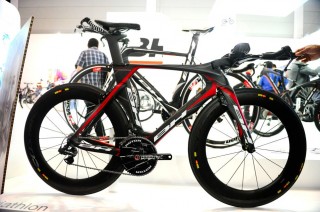 A new bike triathlon semi-integrated with particular brake installation from the chassis the Spaniards.
A new bike triathlon semi-integrated with particular brake installation from the chassis the Spaniards.
Instead of a fully integrated system for the stem, BH uses a standard steerer tube for mounting the handlebar. The top tube of the frame is raised to eliminate the gap (the scalinoo) behind the stem in the low position, with a stem created ad hoc to blend smoothly with the shape the frame. Special steering tube spacers may raise the stem up 45 mm above the steer tube, just like a typical stem, if you want to raise higher the handlebars.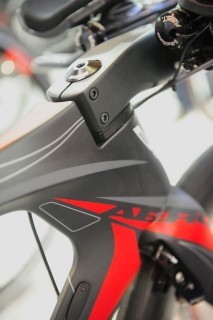 The frame measures graph BH on show at Eurobike was devoid of signs of the stack and reach, the best way to evaluate the features of adaptation of a bicycle. Standard frame sizes were available and indicate that the frame Aerolight fits in a manner similar to the current GC Aero tri bike. The top tube and head tube length suggest that this bike is adapted moderately vertical driving styles instead of forcing triathletes to support only aerodynamic positions thrusts.
The frame measures graph BH on show at Eurobike was devoid of signs of the stack and reach, the best way to evaluate the features of adaptation of a bicycle. Standard frame sizes were available and indicate that the frame Aerolight fits in a manner similar to the current GC Aero tri bike. The top tube and head tube length suggest that this bike is adapted moderately vertical driving styles instead of forcing triathletes to support only aerodynamic positions thrusts.
BH uses two additional bays for bottle cage on horizontal tube just behind the stem, to give the rider the ability to add additional devices of hydration. The Spanish company is planning to create a bottle or a porta-objects/fingers to be installed on a horizontal pipe, filling the empty space if you drive with a stem in high position.
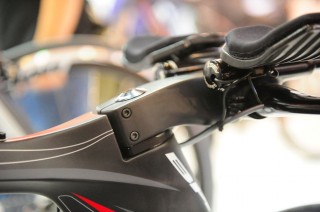 Peter Shigo, manager of R & D, BH has been designing the bike with a specific rule of bracket-BB386, which is quite large, in order to achieve the goals of lateral stiffness. They do not consider other types of BB. The aerodynamic characteristics of the bike have been designed in relation to that specific feature sets.
Peter Shigo, manager of R & D, BH has been designing the bike with a specific rule of bracket-BB386, which is quite large, in order to achieve the goals of lateral stiffness. They do not consider other types of BB. The aerodynamic characteristics of the bike have been designed in relation to that specific feature sets.
After completing the project of Aerolight, BH has tested a prototype form equal to that of the final bike, wind tunnel FASTER in Arizona. The shape of the frame has not been altered or modified as a result of this test, it was just a "validation", says Shigo.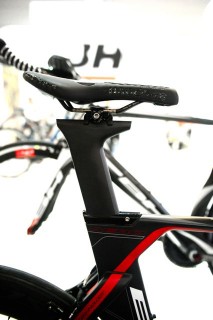
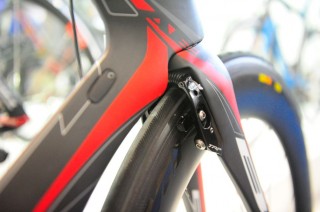
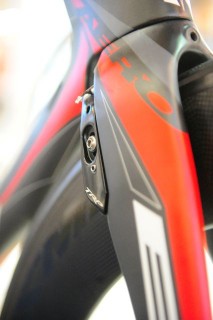 Borrowing a strategy of Cervelo, BH has blunted the tube where the bottle cage mounts, so wrap the bottle to improve performance in real race conditions and not the test conditions without water bottles mounted on the bike.
Borrowing a strategy of Cervelo, BH has blunted the tube where the bottle cage mounts, so wrap the bottle to improve performance in real race conditions and not the test conditions without water bottles mounted on the bike.
As you can see in the photo gallery, the rest of the tube is an aerofoil with a ledge down that acts as an invitation of the front wheel. The steering tube is wide enough for needs of stiffness, and uses a headset 1-1/8th ". Shigo says that the frame has been designed in consideration of the UCI, "with all forms of pipes in accordance with the 3: 1 ratio imposed by the governing body of cycling, ...
Instead of using a single brake support, Shigo has provided many so that the frame Aerolight can use different brake types. The bike in view and all complete bikes planned for 2013 include use of TRP V-brake, but we can also accommodate the typical road style clamps.
"The brakes give you the freedom to use virtually any brake on the market," says Shigo. "During the development cycle, came out interesting proposals for the brakes, in particular hydraulic calipers RT 8TT Magura, and so we wanted to be able to keep them. The multiplicity of brakes provides flexibility in price, and also provides consumers with the ability to create the bike you want. "
The downside of this flexibility seems to be mainly aesthetic: brake unused media become slightly unsightly (open hole) but this has no functional impact on the bike.
BH sells the set frame and four full versions of Aerolight.. GH Aero frame will remain the Foundation of their bike triathlon at lower prices
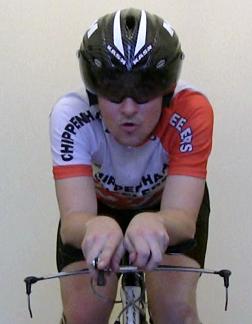 It's a fascinating subject, which requires a precise mixture of biomechanic and aerodynamic to meet aspirations often highly competitive cyclist. These two factors can be either complementary or contradictory to the position to be taken and can have a significant effect on performance and comfort during a time trial or Triathlon.
It's a fascinating subject, which requires a precise mixture of biomechanic and aerodynamic to meet aspirations often highly competitive cyclist. These two factors can be either complementary or contradictory to the position to be taken and can have a significant effect on performance and comfort during a time trial or Triathlon.
Geometry of a TT bike
It's a geometry in response to the conflict between power and efficient aerodynamics. The technique is to adopt an upright position of the seat tube and rotate forward substantially the cyclist around the bottom bracket.
Biomechanical efficiency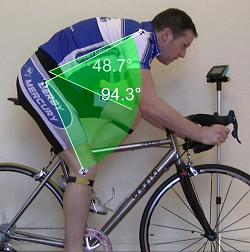 Some people believe that a typical Time Trial position uses different muscle groups from traditional cycling. This may be true for the arm and shoulder muscles, but if you compare the main anatomical corners a cyclist on the road with an aggressive posture ones TT are very similar. In both of these positions you rotate your pelvis forward to stretch the glutes and hamstrings!. This to the detriment of the hip flexors, which are shortened, but the overall benefit is positive. Both of these positions are limited by how much the bust can be tilted forward and the fact that the minimum angle of the hip (48.6 48.7° and° shows here) is reduced to the point where you reach the limits of flexibility and blood flow is restricted. Similarly the hip angle in full leg extension could be a limiting factor as in this position (94.3°/94.5°), the hamstrings are fully stretched. Biomechanical efficiency and aerodynamics are compatible between them by inviting cyclists to rotate forward, but only to the extent that the reduction of the capacity to generate power is no longer sufficiently compensated by an improvement of the aerodynamic resistance front.
Some people believe that a typical Time Trial position uses different muscle groups from traditional cycling. This may be true for the arm and shoulder muscles, but if you compare the main anatomical corners a cyclist on the road with an aggressive posture ones TT are very similar. In both of these positions you rotate your pelvis forward to stretch the glutes and hamstrings!. This to the detriment of the hip flexors, which are shortened, but the overall benefit is positive. Both of these positions are limited by how much the bust can be tilted forward and the fact that the minimum angle of the hip (48.6 48.7° and° shows here) is reduced to the point where you reach the limits of flexibility and blood flow is restricted. Similarly the hip angle in full leg extension could be a limiting factor as in this position (94.3°/94.5°), the hamstrings are fully stretched. Biomechanical efficiency and aerodynamics are compatible between them by inviting cyclists to rotate forward, but only to the extent that the reduction of the capacity to generate power is no longer sufficiently compensated by an improvement of the aerodynamic resistance front.

Aerodynamics
Most people are aware that the aerodynamic drag of a body is a function of its drag coefficient (Cd) and the front section (A). A cyclist in a squatting position will have a Cd approximately 0.9, that doesn't sound very good, but it's still better than if it were just standing (1.20) or compared to a flat plate (1.17). To improve our aerodynamics (CdA) we need to improve both Cd and A, and can be a reasonable attempt to reduce frontal area. Without using a wind tunnel, one can only hazard a guess to improve Cd.
How to reduce the frontal area:
Lower the front end of the bike.
Make sure that your elbows are inside too.
Bring your knees towards the inside of the frame.
Move between their shoulders and keep the head
Wear close-fitting clothing.
How to improve the Cd.
Many people can observe how air molecules interfere on the front surface of any body in motion, increasing the pressure and thus creating resistance. Very important is the separation of the airflow, which causes a reduction in pressure behind the object. The aerodynamics will try to avoid this by keeping the laminar flow around the object for as long as possible, avoiding sudden changes of form. This gives the classic aerofoil section (as a dirigible) which has a Cx of 0.02. As a rough guide any aerodynamic bike part must have a width-to-length ratio of approximately 1: 4 in order to be effective (1: 2 is only marginally better than a round tube). This isn't particularly easy on a bike, but we can see a lot of examples like aerodynamic helmets, frame shapes, aerobars, rays and high profile wheels or disc.
The use of aerodynamic parts is limited only by budget, as it is a job to be done in a wind tunnel.
Simple guidelines to improve Cd are as follows.
With the adoption of a horizontal back and forearms to nears US 1: 4 ratio for these parts of the body.
Reduce the turbulence with the passage of the cables internally.
Use your forearms to guide the air flow on the flanks.
Reducing skin friction with close-fitting clothing.
Comfort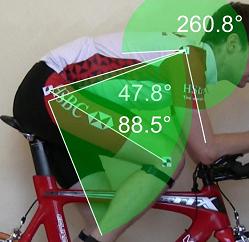 The correctness of a TT or conventional racing can largely be resolved by a simple question.
The correctness of a TT or conventional racing can largely be resolved by a simple question.
How much and how often you are migrating towards the tip pushing phase saddle?
If the answer is more than 25 mm thick, then the location is not optimal and it can be faster and more comfortable with some modifications.
Observe what happens when slide forward on the saddle of only about 10 mm:
The minimum angle of the hip POPs.
The hip angle at maximum extension of the leg opens.
The shoulder angle reduces.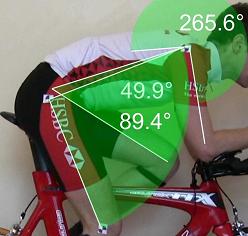 Here in the pictures is not shown, but reduces the maximum angle of the knee as a result of the fact that slipping forward you an actual lowering of the height of the saddle.
Here in the pictures is not shown, but reduces the maximum angle of the knee as a result of the fact that slipping forward you an actual lowering of the height of the saddle.
Ideally, the position should allow the bike to remain planted in the saddle, while retaining the ability to unleash power, with your arms and shoulders should be relaxed for most of the race.
Appendices handlebars.
Aerobars positioned on the handlebars of racing bikes are very popular. The mistake that many people make is to put them too low, because they cannot get comfortable on them. There are two approaches to regulating the aerodynamic appendages, depending on whether or not to change the position of the saddle
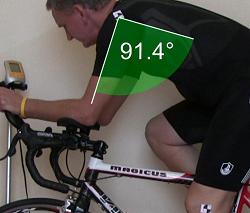
1) the position of the saddle does not change.
If on your race bike you ride and comfort often adopt the low grip on the handlebars, you're working within your limits of flexibility. In this case, play your torso angle you have with the lower outlet also on location on appendages tri. This means that the angle of the trunk does not increase nor decrease as you move from lower handlebar grip to grip on the appendices. But then this setting change may seem unnecessary; actually with the appendices assume a position of the arms, wrists and hands that can be very comfortable over long distances.
2) saddle position changes (the saddle moves forward)
Move forward the saddle offers the possibility of benefiting from a lower position. If you are struggling to pass the time on the lower grip of the handlebars, it is likely that your hip angles are too tight. As we saw earlier, moving forward may relieve this tension by moving the hip. Sometimes there are seats that have insufficiently adjustable guides to move the saddle forward far enough, and then on a saddle or a different seat. Please note that advance too far can affect handling and bicycle riding.
However, placing the bars so that the angle between the upper arm and upper torso is approximately 90° to 110°: This gives the best compromise between comfort and control. This angle must also ensure the absence of conflict between your knees and arms, or between the knees and elbow pads in out riding on the way up.
Summary:
- Very flexible Only cyclists are able to support max and min angles of the hip lower than 90° and 45°, respectively.
- The maximum angle of the knee may be a little lower, but still between 140° -150°.
- Keep the angle between the arm and trunk between approximately 90° to 110°.
- Don't bother with horizontal crank to get the knee over pedal spindle (KOPS), because the rule is no longer valid on frames with the stem tubes more erect.
- If you buy handlebar appendages to get more aerodynamic than the lower socket, you must move the saddle forward.
- Tilt the saddle slightly nose down.
-The appendices which provide wrists straight position are more comfortable, especially for long distances. Appendix a double curve or straight extensions cause increased fatigability of the wrists.
The blood volume of the human being is made up of the arteries that bring oxygen to the muscles and, for more than 80%, from veins that eliminate toxins. Located at a distance from the heart and lungs, the venous blood of the calf meets many difficulties during the ascent. During the course of a sporting activity, be it amateur or intense pleasure, calf behaves like a real sponge it fills up quickly. If stress is intense, the cardiac output can increase up to 5-6 times and the blood flow to muscle over 20 times. This translates into a hydraulic overload with venous hypertension and expansions that can be due to a bad muscle oxygenation (tiredness, heaviness, cramps ....) and a decrease in their productivity and performance. The repetition of these conditions leads to fragility of the muscle fibres with increased risk of injury. To address this situation, we must act on the calf, this famous peripheral heart.
It is clear that  the real target is the calf and that pressure must be greater at this level and not at the ankle. In fact, in ankle-level sport there are no muscles but bones, tendons, nerves and blood vessels. The vessels and nerves are both inaccessible to compression because it protected (the back) is somewhat vulnerable (vases and nerves fibulari) in the front. Furthermore, according to the law of Laplace, the pressure transmitted to the level of the calcaneus tendon (Achilles) should not be strong because poorly supported.
the real target is the calf and that pressure must be greater at this level and not at the ankle. In fact, in ankle-level sport there are no muscles but bones, tendons, nerves and blood vessels. The vessels and nerves are both inaccessible to compression because it protected (the back) is somewhat vulnerable (vases and nerves fibulari) in the front. Furthermore, according to the law of Laplace, the pressure transmitted to the level of the calcaneus tendon (Achilles) should not be strong because poorly supported.
That's why Progressive compression with its gradual pressure specifications (weak and stronger ankle to calf) is perfectly suited to the physiology of sport. Through his anatomical structure conical or rounded and in relation with the law of Laplace, the calf will always sportsperson of strong pressures and adapted for efficiency and optimal tolerance. This measurement of pressures cannot be currently calculated through the research and Development Centre BV SPORTS grazi para-clinical examination (Eco-color Doppler, MRI scanners), thanks to clinical trials bought (randomized double-blind trial of grade A) and to a continuous and uninterrupted clinical experience on athletes for more than 15 years. It is essential to remember that BV SPORTS is the precursor and the inventor of the compression for the recovery and stress Booster (without foot sock) intended for sportspeople and their physiology in particular.
Patent of progressive contention BV sports. The compression effect specifies BV SPORT acts on the main reserve of the calf, proper muscle and vascular sponge. Calf fit pressures allow the peripheral heart lower effort against a quicker elimination of venous blood oxygenated and pain of toxins (lactic acid, CO2 free radicals, etc.) Minimum pressures if not void at foot level.
BOOSTER Patent BV Sports. The restraint effect or Aponeurosis allows better containment and muscle performance during stress and COMPRESSIVE effect, thanks to the pressure adapted à this improves oxygenation (turbo effect) and calf congestion delays under stress. Taken regularly the concept SPORTS BV (recovery + Booster) improves performance and reduces the risk of injury.

 In sports, we have defined what was to be the range of pressures to apply Progressive compression on ankle (weak pressures) and calves (strong pressures) for a maximum benefit without side effects. The analysis of the behavior of the veins in particular through EDC muscle at rest or under stress and pressure monitoring through the meter allowed us to fine-tune the stocking intended for recovery, wellness and the Booster. The above has led us to file a patent Progressive compression, which owns BV sports.
In sports, we have defined what was to be the range of pressures to apply Progressive compression on ankle (weak pressures) and calves (strong pressures) for a maximum benefit without side effects. The analysis of the behavior of the veins in particular through EDC muscle at rest or under stress and pressure monitoring through the meter allowed us to fine-tune the stocking intended for recovery, wellness and the Booster. The above has led us to file a patent Progressive compression, which owns BV sports.
 These ultra-modern diagnostic techniques have validated the concept of Progressive compression and distribution of pressure to be applied on all the tissues (FAT, muscle, tendons) and blood vessels (arteries, veins, lymph) on all of the leg (from knee to foot). The calf should be treated as a peripheral heart submissive sometimes stress physiological safety during exertion and recovery. Through a specific manufacture, the restraint effect or Aponeurosis of the Booster allows you to increase your muscular performance and retention. The adjusted compression effect by reducing the likes of veins and residual volume allows a better oxygenation during exertion and a quick elimination of toxins in the recovery phase. The contribution of the Progressive compression improves performance SPORTS BV by means of a good recovery recovery but also by optimizing the functioning of the muscular and vascular pumps of the calf
These ultra-modern diagnostic techniques have validated the concept of Progressive compression and distribution of pressure to be applied on all the tissues (FAT, muscle, tendons) and blood vessels (arteries, veins, lymph) on all of the leg (from knee to foot). The calf should be treated as a peripheral heart submissive sometimes stress physiological safety during exertion and recovery. Through a specific manufacture, the restraint effect or Aponeurosis of the Booster allows you to increase your muscular performance and retention. The adjusted compression effect by reducing the likes of veins and residual volume allows a better oxygenation during exertion and a quick elimination of toxins in the recovery phase. The contribution of the Progressive compression improves performance SPORTS BV by means of a good recovery recovery but also by optimizing the functioning of the muscular and vascular pumps of the calfWe publish a video made in the pool di Subbiano (AR), in which Gianluca Calfapietra responsible for Jhonny Forhans Triathlon provides useful advice for the triathlete who wants to improve his swimming technique. In bath, to perform with great skill the exercises proposed by Calfapietra, a Fabio Gebeyehu, fortissimo Triathlon athlete of Arezzo, then signed in Johnny Triathlon.
View Gebeyehu, listen Calfapietra ..... and good workout at all!!
We publish here a video very useful by the Technical Education Field of FIN (Italian swimming Federation), which deepens the educational and technical aspects of the style back. Watch carefully because useful to everyone, beginners and racers.
Read more: Amino acids: what are they and what is their use?
We publish here a video very useful by the Technical Education Field of FIN (Italian swimming Federation), which deepens the educational and technical aspects of dolphin. Watch carefully because useful to everyone, beginners and racers.
We publish here a video very useful by the Technical Education Field of FIN (Italian swimming Federation), which deepens the educational and technical aspects of frog style. Watch carefully because useful to everyone, beginners and racers.
After the marathon it is important to regenerate your body, make sure you remove all the accumulated fatigue in 42km195mt. The days of competition are strictly set on energy, mineral recovery, mental muscle. It is advisable for every aspect making the necessary precautions. For the energy aspect is critical feeding well and in a balanced manner and. ..
it. .. preferring high glycemic index carbohydrates after the race and medium/low glycemic index in the next few days. Then you should choose protein sources (fish and white meat) to rebuild depleted muscles and the muscle fibers destroyed by repeated microtrauma.
It is also desirable to drink and integrate with minerals after the race and in the following days. Finally, most importantly "pull the plug" from the race for a few days to regenerate the mind. After making these measures due to recover is important to reorganize the preparation.
The ability to rearrange the preparation are different:
1°: participate in a marathon within 1 month to take advantage of current physical condition;
2°: participate in the half marathon within a month;
3°: participate in regional Championships 10 km FIDAL.
Let's see how to manage the preparation for different solutions.
Preparing for a marathon after a month
Us amateur runners we are fascinated by the idea of running two marathons within a few months of each other. Generally speaking if the previous Marathon was handled well without having accused no energy crisis it is possible to exploit the good physical condition of the moment and plan a second Marathon after 1 month (4 weeks), all depends on your ability to recover, which in turn is conditioned by your physical condition and technique (most are trained and better recovery after race), from your age (younger you are and the faster the recovery).
How do I schedule weeks post Marathon?
The physical capacity to maintain trained in the race are:
Aerobic stamina through sessions of slow Travel and travel media
-Aerobic Power, through Repeated sessions short, medium and long
Aerobic stamina through Specific sessions of Marathon pace race
-Joint mobility, using appropriate exercises to improve mobility and elasticity
Primarily the physiological goal to be reached in the weeks after race is to keep high displacement of the body through exercises that improve the anaerobic threshold (see newsletter 11 06 12 aerobic Power), all types of repeated, rapid and short (or short races). It is also important to maintain trained aerobic and particularly the specific resistance by means of rhythm training Marathon. There is no need to carry out other excessively long workouts, simply insert a session of 21/25 in two weeks after the marathon. Whatever the next competitive Marathon goal these physical qualities you must keep them trained as much as possible, especially as I improve the speed of travel. It is also crucial to enter sessions of stretching and joint mobility to regenerate the
muscles, detendere muscles and relieve joint stress.
If the goal is to participate in the regional championships on 10, Fidal then we can re-enter
a point of muscle strengthening is a natural load (climbs) and overloads with isotonic machines, anything to consolidate muscle strength.
If we are to take part in a half marathon after the Marathon there will always maintain high anaerobic threshold
but you do not need to perform any other specific training of long slow, will be more important to include sessions
average race pace half marathon or the short fast to improve the anaerobic threshold.
Now we see the different training tables based on the objective to be reached after the marathon.
Table (A) training to prepare for a marathon after 1 month from the previous

Table (B) training to prepare for a half marathon after 1 month from Marathon

Table (C) training to prepare for the Championship of FIDAL after the Marathon 10 km

The main difference in reorganizing the training after a marathon is when you must attend
FIDAL regional Championships 10 km, where the goal is to compete every Sunday, or nearly so, then you need
to train a lot about anaerobic threshold velocity, and use the running slow to regenerate the body. You could
make a point of aerobic resistance on Sunday which did not compete with Long Slow workouts.
Good run at all!
Prof. Abdullah Ignazio
We publish here a video very useful by the Technical Education Field of FIN (Italian swimming Federation), which deepens the educational and technical aspects of freestyle. Watch carefully because useful to everyone, beginners and racers.
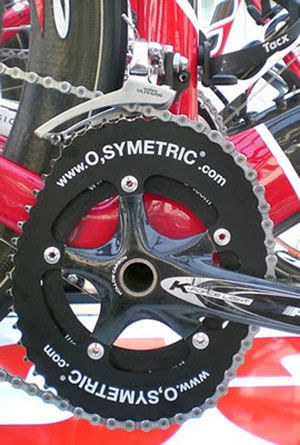 Osymetric crowns are designed by Ing Rocks and Jean Louis biomechanical Talo two
Osymetric crowns are designed by Ing Rocks and Jean Louis biomechanical Talo twoENERGY SYSTEMS AND PERFORMANCE
 Before talking about our body's energy systems that are triggered by a physical effort, we see the definition of the training concept. Training can be understood as " programmed, organized, timed delivery of certain biological stimuli, which has the ultimate goal of improving sports performance." Each racer knows that after a training load our body receives stimuli that allow it to improve, such improvement is achieved if the stimulus is adapted to its current condition, otherwise it is likely to bring the organism beyond its ability to endure, Going to the Overtraining phenomenon. For this reason it is necessary that the training stimulus, both as quantity and as intensity, is as personal as possible, gradual and respectful of the law of loading and unloading , which is nothing but the Supercompensation Act. Ultimately, after having delivered a body-stimulating stimulus (positive stress) and after a general fatigue post-workout phase, there is an adaptation and a subsequent improvement in performance (supercompensation). However, if the stimulus or stimuli were too intense and repeated over time with insufficient rest and neuromuscular recovery, then Overtraining would be a decay.
Before talking about our body's energy systems that are triggered by a physical effort, we see the definition of the training concept. Training can be understood as " programmed, organized, timed delivery of certain biological stimuli, which has the ultimate goal of improving sports performance." Each racer knows that after a training load our body receives stimuli that allow it to improve, such improvement is achieved if the stimulus is adapted to its current condition, otherwise it is likely to bring the organism beyond its ability to endure, Going to the Overtraining phenomenon. For this reason it is necessary that the training stimulus, both as quantity and as intensity, is as personal as possible, gradual and respectful of the law of loading and unloading , which is nothing but the Supercompensation Act. Ultimately, after having delivered a body-stimulating stimulus (positive stress) and after a general fatigue post-workout phase, there is an adaptation and a subsequent improvement in performance (supercompensation). However, if the stimulus or stimuli were too intense and repeated over time with insufficient rest and neuromuscular recovery, then Overtraining would be a decay.
This suggests that every training stimulus must have its place in the training program and must take into account several parameters that are suitable for improving sports performance:
I would like to dwell on the concept of the training stimulus that must be focused and specific for that race we are preparing, so preparation must reflect certain conditions. To better understand this concept we see before analyzing the Energy Systems used by our body to provide energy.
ENERGY SYSTEMS
Very simply, the Energy Systems are nothing more than the metabolic pathways used by our body for the reshaping of the ATP molecule (adenostrifosphate) and that in doing so there are generally three main energy systems, which can have different power and capacities based on To the use of the energy produced. The three systems can be classified into:
Phosphagene system:
Everyone knows this system as an anaerobic anaerobic energy system since it does not use oxygen (anaerobic) and does not produce lactate (alatacido). Such a system uses Phosphagene as a rich molecule of energy, which in humans is represented by phosphocretin. What we are interested in training is that this system is very powerful, it supplies energy quickly, but it runs out in seconds (eg sprint, inteval training). So it is the first to intervene when the effort is intense and of limited duration.
Glycolysis System
This system mainly uses the energy substrate as carbohydrates, which we know are named Glycogen and Glucose. This process is very important and becomes crucial, above all on three occasions and conditions:
One has to keep in mind for our training and therefore the setting of running training sessions that this system (with pyruvate production) can take two distinct ways:
A) lactate-reduced pyruvate and talk of anaerobic glycolysis, which is much more potent, but unprofitable compared to Oxyphosphorylation (Aerobic Glycolysis);
B) pyruvate completes the oxidation process with carbon dioxide and water, through oxidative phosphorylation, then we talk about Aerobic Glycolysis, which is less powerful but definitely more profitable with the passage of training time
Oxidative phosphorylation system
This system is very productive and effective, accounting for about 90% of the total ATP (adenocyphosphate) production of the body. Oxidative phosphorylation is carried out by a series of biochemical reactions, which reactions can be divided into:
We do not care much about the merit and the biochemical dissertation of these processes, what matters to know is that this aerobic energy system (oxygen presence) to be effective and thus trained, one must put in and propose during the preparation of a series Of training sessions aim at improving oxygen transport to cells (mitochondria) where it will eventually be used. So they are nothing more than training methods that are part of the improvement of the central components of our body's aerobic system. It should also be borne in mind that this Oxidation Phosphorylation System uses foods we ingest with nutrition to provide energy, so it is about carbohydrates, lipids, and in exceptional cases even muscle proteins. From a biochemical point of view we can state that the oxygen extracted from the air we breathe, binds to hemoglobin (blood protein), is present in the red blood cells to be shed on the muscle at the myoglobin, then to reach the mitochondria present in the cell . That is why it is very clear that the greater the amount of hemoglobin in the blood, so the red blood cells, the greater the oxygen intake, the consequence the so- called Hematocrit will increase . Aerobic training and above all workout in the high seas for a certain period of time (at least 3 weeks) at an altitude ranging from 1800 to 2300mt asl, leads to an improvement in hematocrit, mainly due to a normal increase in ' Erythropoietin that stimulates the production of new red blood cells.
Balance of Energy Systems
In practice, during the training, insert specific training to improve anaerobic glycolysis (eg interval training sessions, repeated in the plains) leading to a massive lactic acid production, does nothing but interfere with the fat utilization system (Lipid Power ). From this it can be seen that if we are specifically preparing a Marathon, we can not force too much in the sessions of Interval Training, anaerobic training, when that would interfere with the use of fat during the Marathon. So you need to put the sessions to improve Glycolysis Anaerobic in distant periods of the race, also the percentage of these sessions are limited and the rhythm management is not too high to allow substantial lactic acid production with difficulty to be disposed and reused for Provide energy. So if training to prepare the Marathon needs to improve Lipid Power by Oxidation Phosphorylation, and then to make use of carbohydrate fat mainly as energy substrate, we need to put in training sessions that allow all this .
So, in conclusion, we can say that workouts, their scheduling and time organization must be evaluated in such a way as to calibrate the effects they can make to energy systems, depending on the specificity of the race being prepared. There is no point in improving the Anaerobic Glycolysis System if our goal is to prepare the Marathon, so you will not need to enter many training sessions that will work on the anaerobic threshold, but it will be crucial to improve lipid power at the right time. So let's look at the following two examples of eight week training training that refer to the specific 10km race goal and Marathon. The program includes 4 days a week training for 8 weeks with the aim of achieving maximum performance at the time of the race, all planned with respect to the concept of improvement and balance of the two energy systems Glycolysis Anaerobic (10km) And Oxidative Phosphorylation.
SPECIFIC WEEKS TO IMPROVE ANAEROBIC GLYCOLIS (10km) | ||||
1 | CL 10km + extending | RMP 8 x 1km RG rec 2-3'00 | CL 10km + extending | CM 10km Rgara 10km + 15_25 " |
2 | CL 10km + extending | RBsalita 10 x 300mt rec down | CL 10km + extending | Short Fast Fraction 4 + 4km |
3 | CL 10km + extending | RBP 10 x 500mt - 10 "RG rec 2'00 | CL 10km + extending | CM 12km Rgara 10km + 15_25 " |
4 | CL 10km + extension | Fartlek 10 x 1 'fast + 1' slow | CL 10km + extending | Short Fast Fraction 5 + 5km |
5 | CL 10km + extending | RLP 4 x 2km RG + 5 "rec 3-4'00 | CL 10km + extending | Progressive 10km |
6 | CL 10km + extending | RBsalita 10 x 200mt rec down | CL 10km + extending | Short Fast 6 km |
7 | CL 10km + extending | RBP 10 x 300mt - 20 "RG rec 4-5'00 | CL 10km + extending | CM 14km Rgara 10km + 15_25 " |
8 | CL 10km + extending | Fartlek 10 x 1 'fast + 1' slow | CL 10km + extending | Objective: Race 10km |
SPECIFIC WEEKS TO IMPROVE OXIDATIVE FOSFORILATION (42km) | ||||
1 | CL 10km + extending | RMP 8 x 1km RG + 5 "rec 2'-3'00 | CL 10km + extending | Long Way 24 - 28km |
2 | CL 10km + extending | RBsalita 10 x 200mt rec down | CL 10km + extending | CM 15km Rhythm Marathon |
3 | CL 10km + extending | RLP 5 x 2km + 5 "RG rec 3-4'00 | CL 10km + extending | Long Fly 28 - 32km |
4 | CL 10km + extending | Fartlek 10 x 1 'fast + 1' slow | CL 10km + extending | Progressive Marathon Rhythm 18 km |
5 | CL 10km + extending | RLP 3x 3km RG + 10-15 "rec 4'-5'00 | CL 10km + extending | Long Fly 32 - 36km |
6 | CL 10km + extending | RBP 10 x 200mt rec down | CL 10km + extending | CM 21km Rhythm Marathon |
7 | CL 10km + extending | RM RT Marathon 8 x 1km RM rec 3'00 | CL 10km + extending | Marathon rhythm 15km |
8 | CL 10km + extending | Fartlek 10 x 1 'fast + 1' slow | CL 10km + extending | Objective: Marathon |
Good run at all!
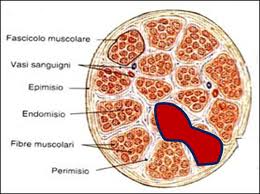 The other pill, as promised. We'll talk about muscle injuries, trying to shed light on a topic where there is more than a few doubts. Muscle injuries are among the most common injuries in sports medicine. Under this generic term including diseases involving an actual muscle damage (direct trauma injuries or bruises and indirect trauma injuries or tears – distrattive lesions) or milder clinical picture which do not cause a true lesion of muscle fibers (contractions and stretching). The most frequent causes of muscle injuries depend on:
The other pill, as promised. We'll talk about muscle injuries, trying to shed light on a topic where there is more than a few doubts. Muscle injuries are among the most common injuries in sports medicine. Under this generic term including diseases involving an actual muscle damage (direct trauma injuries or bruises and indirect trauma injuries or tears – distrattive lesions) or milder clinical picture which do not cause a true lesion of muscle fibers (contractions and stretching). The most frequent causes of muscle injuries depend on: